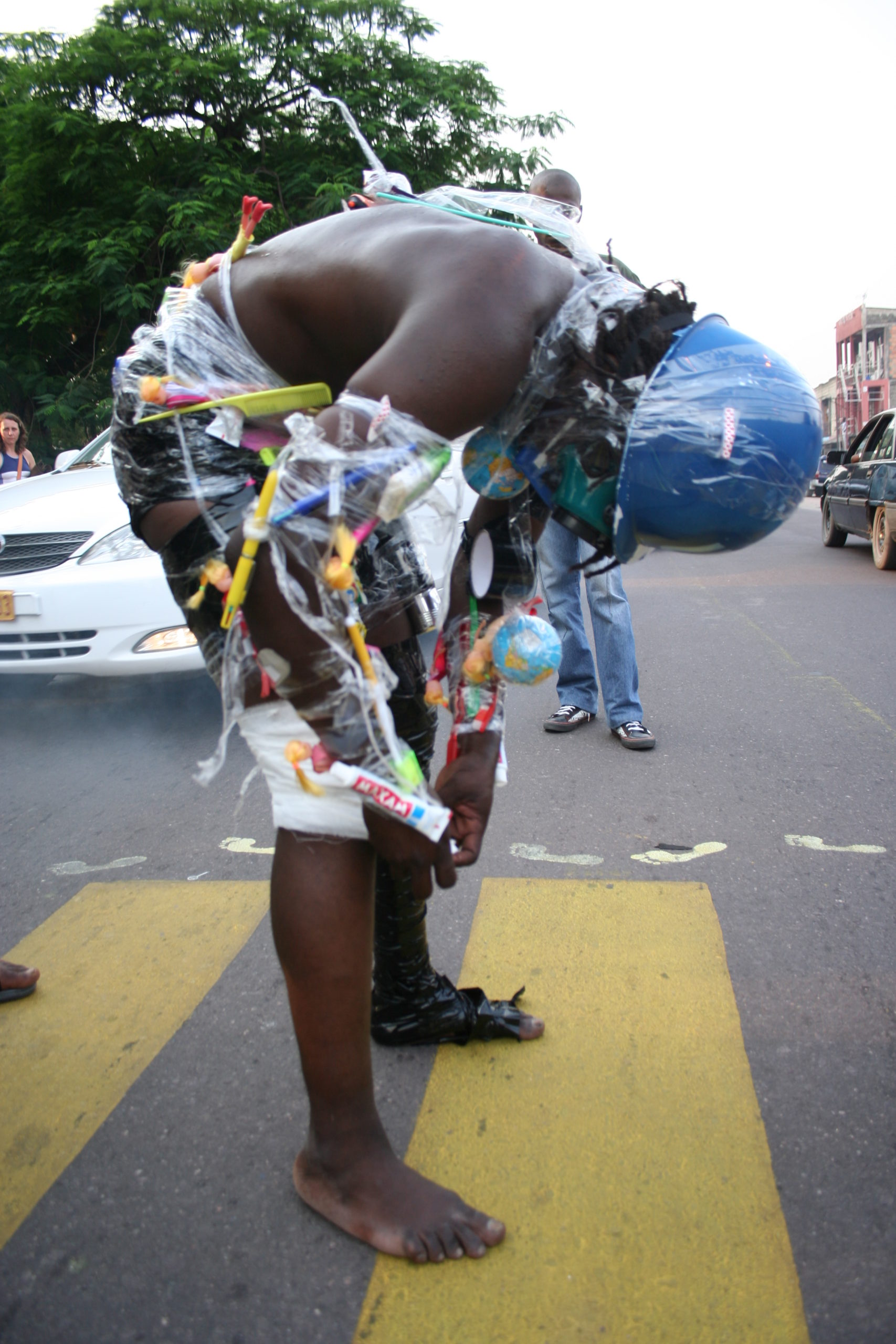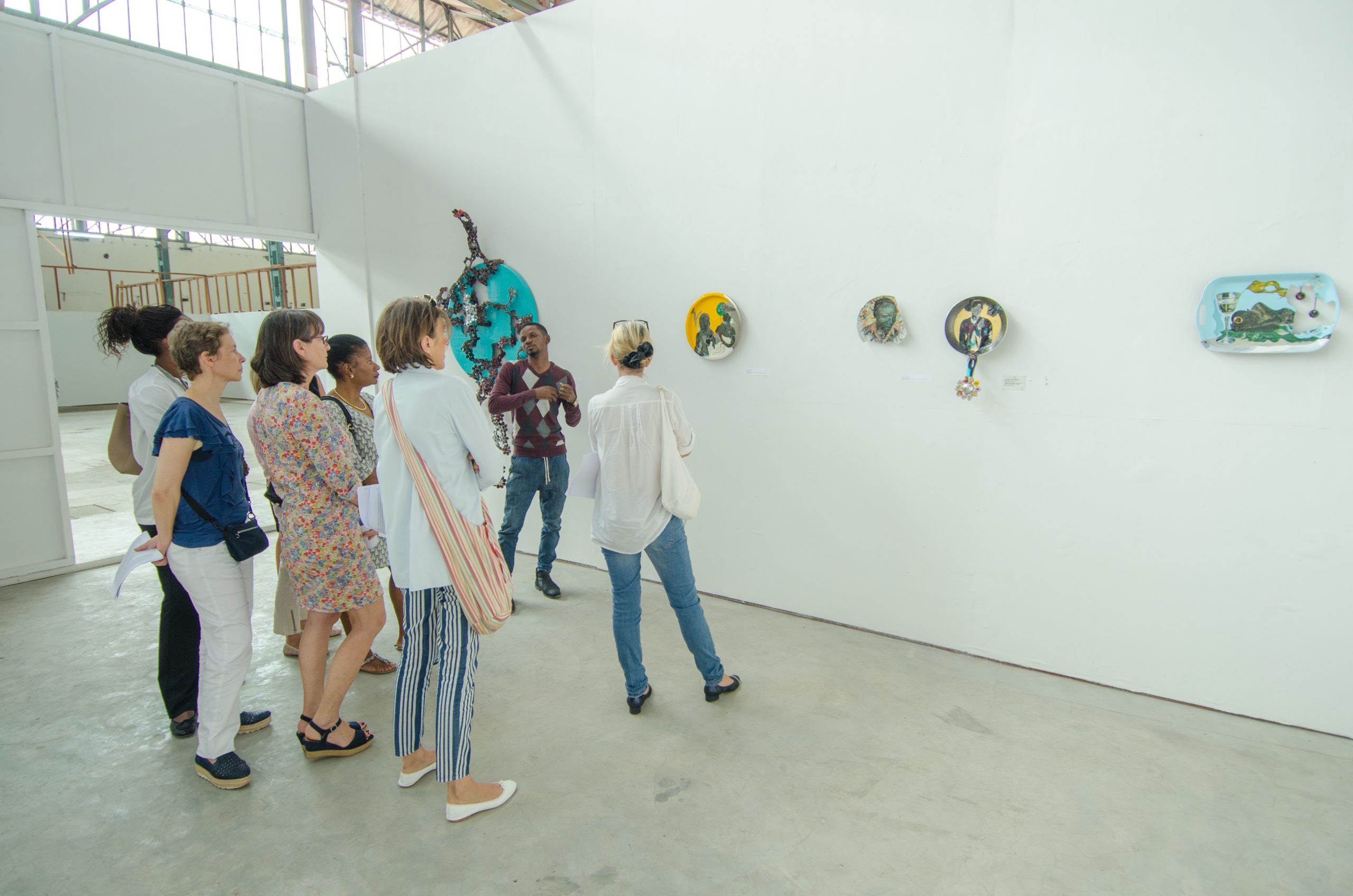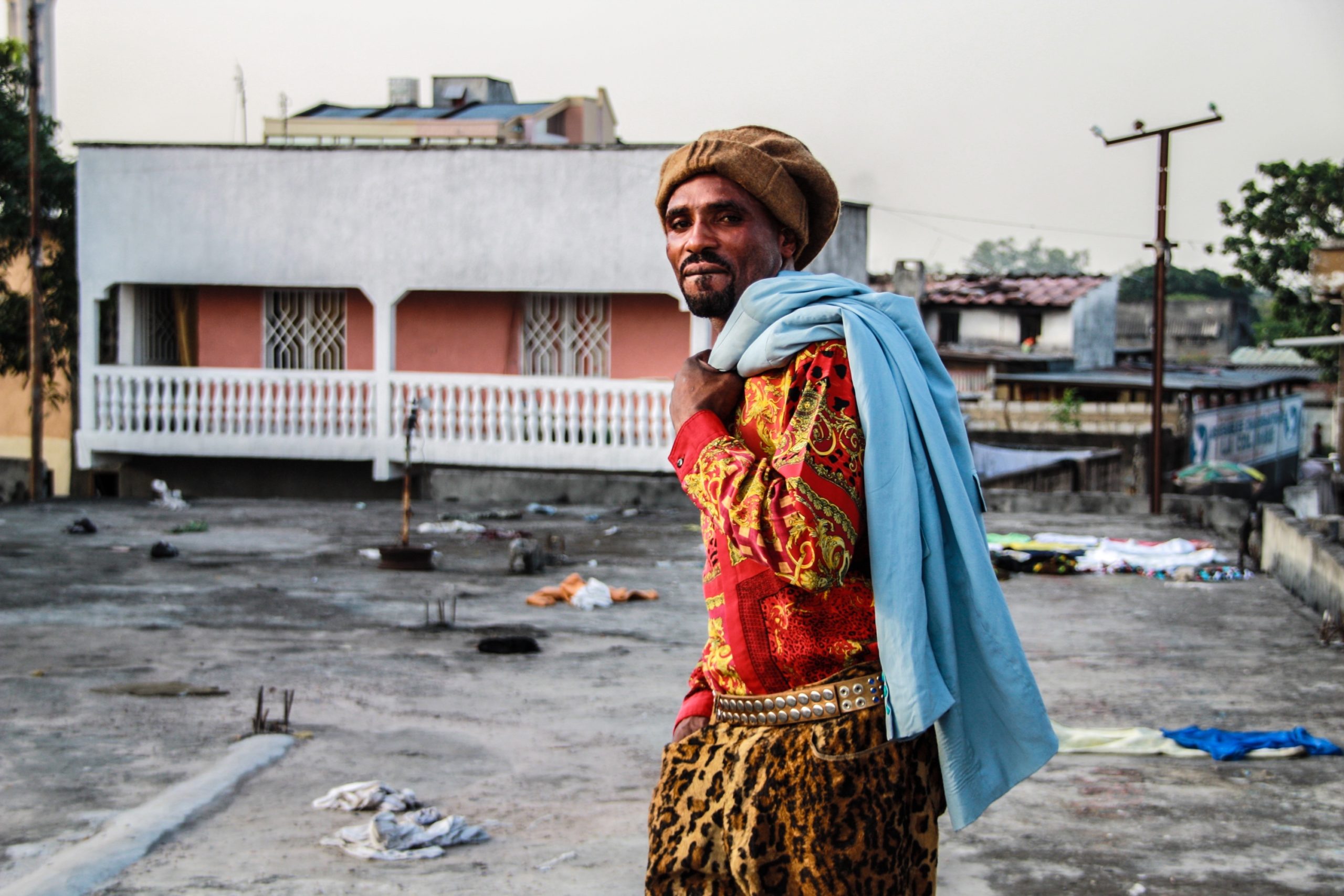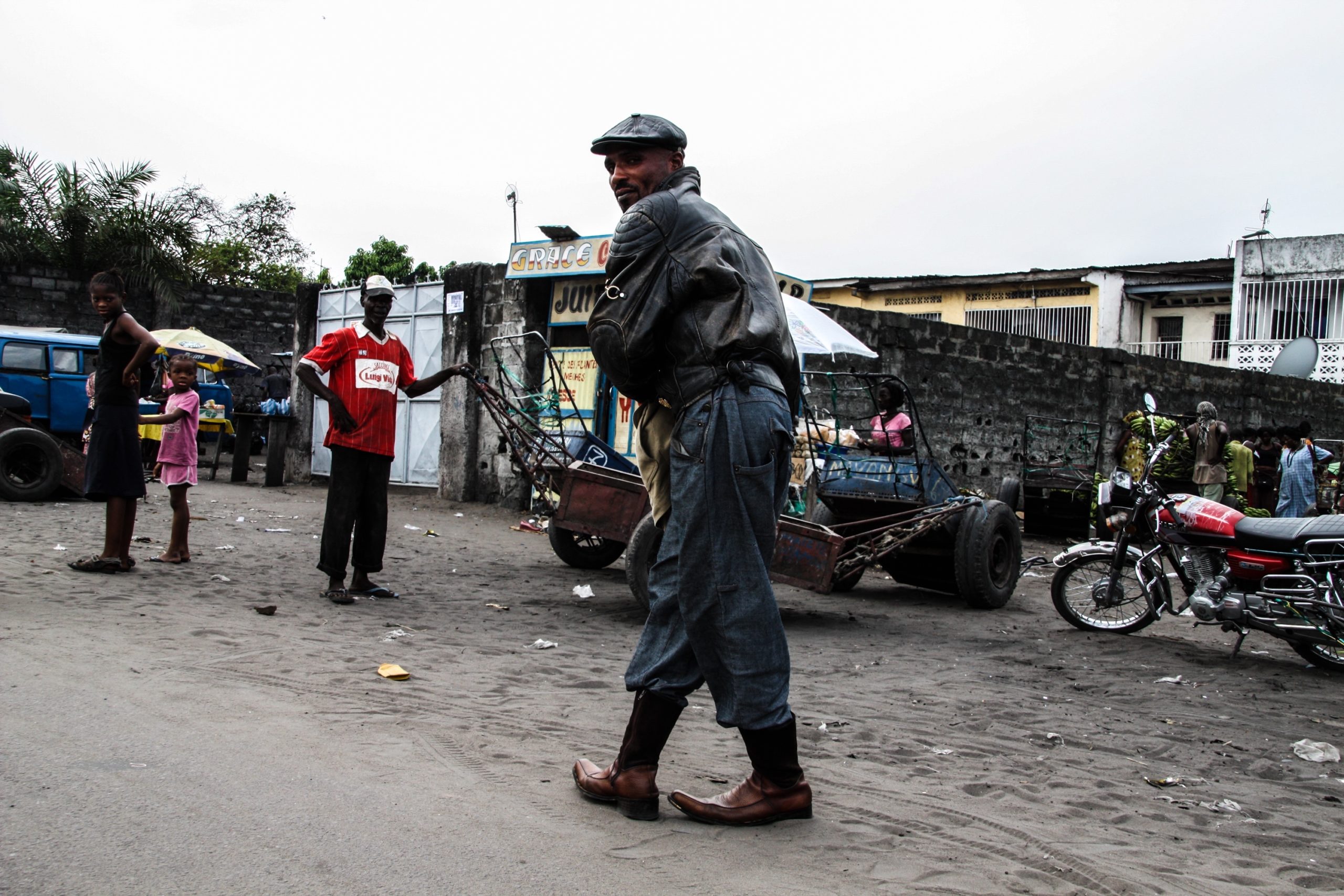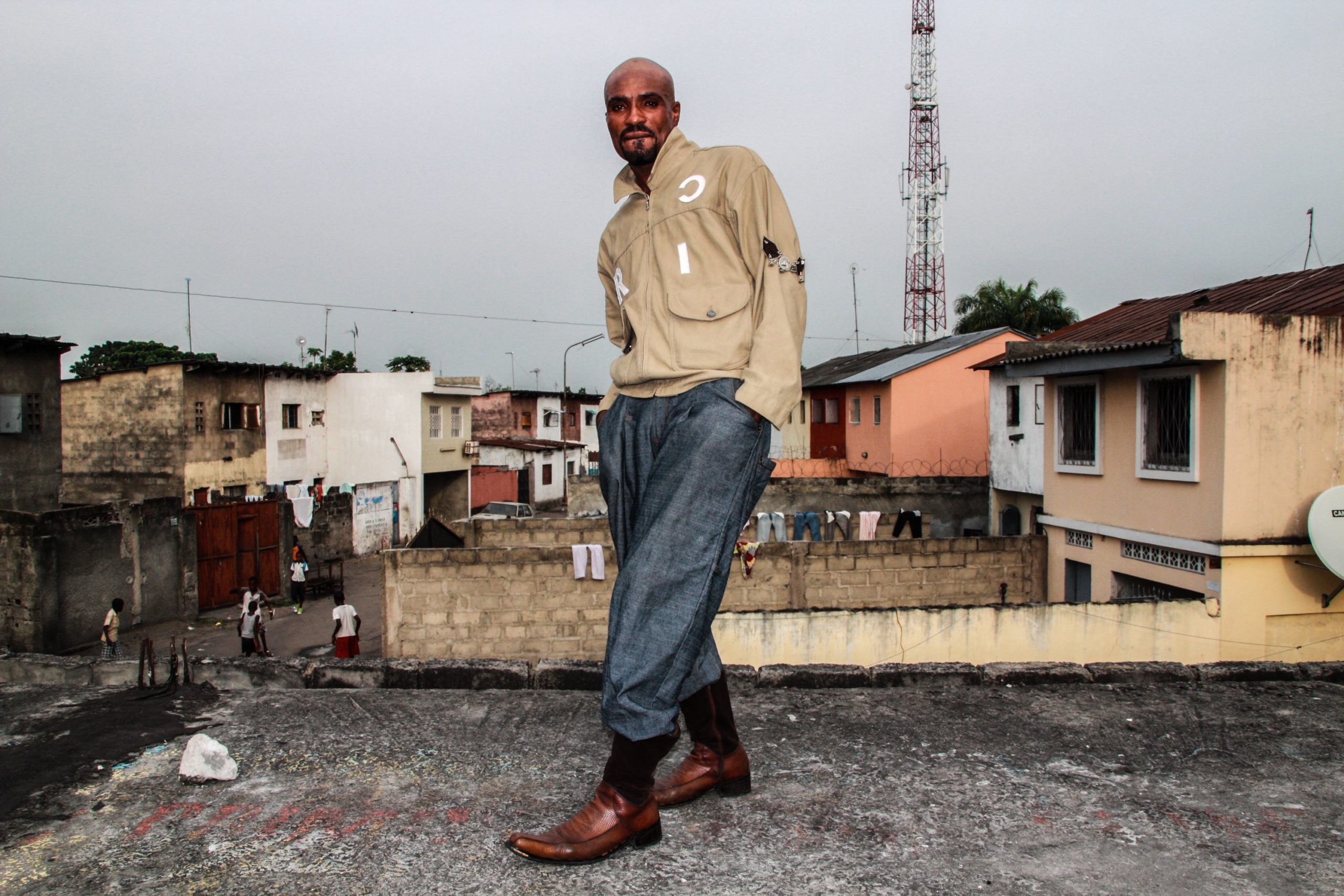Vitshois Mwilambwe Bondo: Para-institutional Kinshasa
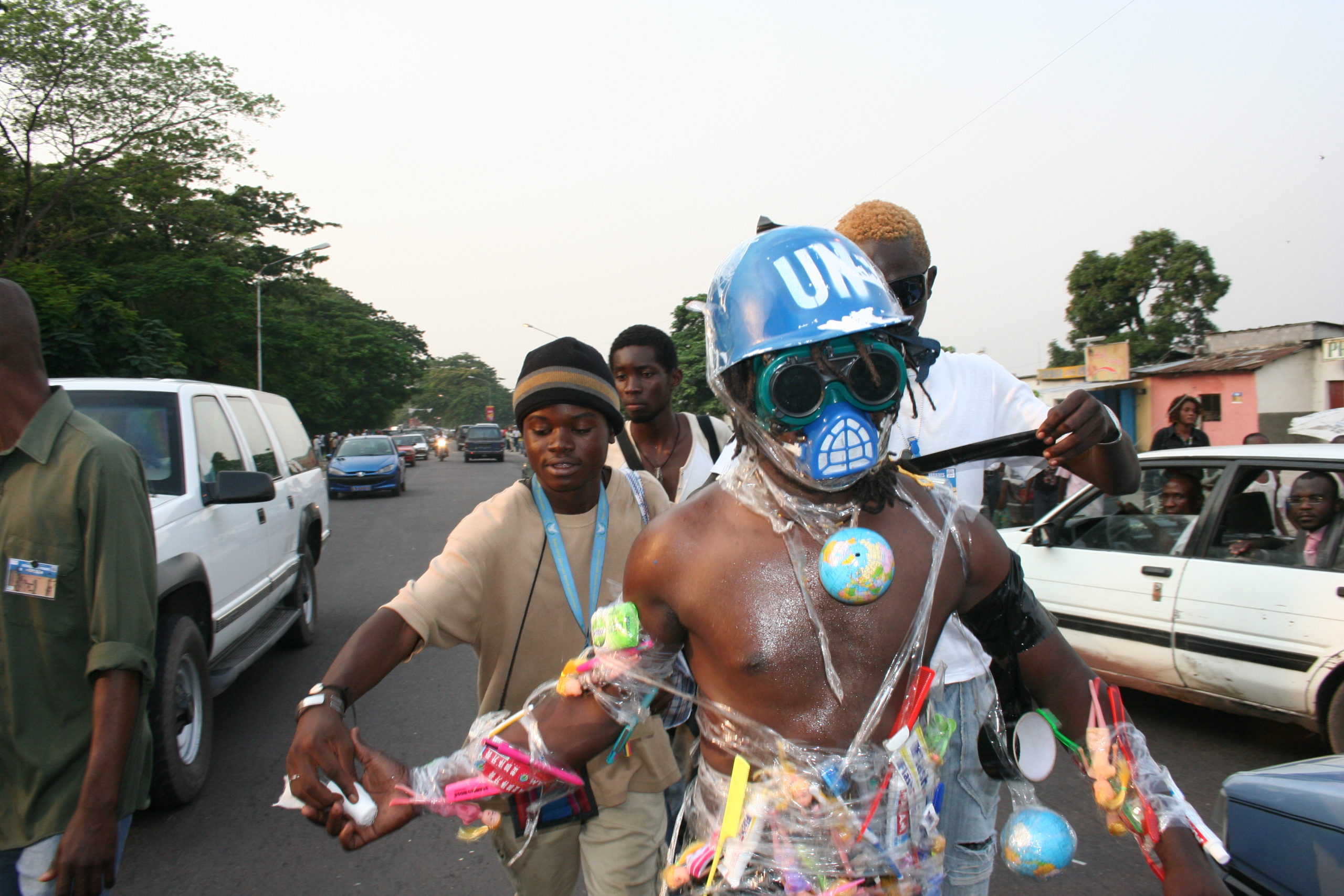
Vitshois Mwilambwe Bondo, 2007, performance [photo: Alain Mohammed Mwilambwe; courtesy of the artist]
Share:
Small, cooperatively managed, and DIY projects and organizations are integral to any healthy arts ecosystem. Such initiatives fulfill vital roles that traditional institutions do not, and these initiatives provide unique experiences for audiences and arts patrons. They are often the laboratories that offer safe spaces for experimentation critical to art practice, and facilitate exchange between and among artists. Traditional museums and galleries, by function and definition, simply cannot do it all, nor should they necessarily try. As with many other sectors, bottom-up and community-centered approaches enable citizens to define the goals, as well as innovative ways to achieve them. Bureaucratically complex institutions governed by powerful boards or governments tend to employ a top-down flow of ideas, often for the sake of efficiency. They apply subjective assumptions, best guesses at what audiences want, international trends that do not work in all contexts, and/or lead charges that prioritize a financial need to comply with vital donors and stakeholders. In contrast, para-institutional community projects tend to work with—and are in more immediate dialogue with—beneficiaries. They are better positioned to assess local desires as they change, and can be immediately responsive, resulting in successful participation and attendance, the extension of which is an enriched and closer community. Such organizations and leadership structures also more accurately contextualize prospective bottlenecks and hindrances regarding such issues as accessibility, relatability, and support. And in doing so, they can anticipate future problems and develop comprehensive solutions relevant to a wider range of socio-economic groups.
In Africa, small arts nonprofits, unincorporated cooperatives, and voluntary “citizens” groups are launching some of the most exciting projects and cultural movements on the continent. From Dar es Salaam, to Lagos, to Lusaka, artistic and cultural innovation thrives at this level. Frequently organized by artist collectives, and by citizens returned from postsecondary education and other opportunities abroad, these projects seek to maximize community assets and strategically respond to needs left unmet by the state. In my frequent travels, I am never more impressed by museums than I am by what I witness on the street. Actively seeking out this sector has become a standard in my curatorial practice.
Vitshois Mwilambwe Bondo, 2007, performance [photo: Alain Mohammed Mwilambwe; courtesy of the artist]
These creative entrepreneurs repurpose citywide patio spaces to create community town halls and transform open air markets into public theaters. Galleries are crafted from shipping containers accessible in coastal cities, and far-reaching networks of professionals who volunteer their expertise are mobilized. Budgetary limitations mean these initiatives need many volunteers to function at their best, especially in Africa, where historical legacies of European conquest and colonialism, as well as ongoing imperialism and foreign interference, continue to breed or exacerbate destabilization, debt, and austerity measures that greatly limit public spending. Fortunately, many people are inspired by these self-starters and their persuasive mission statements, and there is an outpouring of support to impart arts knowledge and expertise with talented curatorial, visual, and performing arts students otherwise lacking access to affordable or local comprehensive arts and career strategy education.
Vitshois Mwilambwe Bondo is but one example of the aforementioned: foreign-educated returnee, actively building a bridge between arts professionals in various countries to create a pipeline to mainstream success for local talent in Democratic Republic of Congo. I met Vitshois when we were participants in Tukutane Dar, a weekend of arts programming in Dar es Salaam, Tanzania, organized by Nafasi Arts Space. We co-led a master class on curation, juried a competition for graduating art students, and sat on a panel at the Tanzanian Ministry of Information, Culture, Arts, and Sports about inter-regional and Pan African exchange and arts organizing. I witnessed his desire to democratize access to the arts for all people, including those in rural environs, as well as his impassioned advocacy for the generations of artists following him. The success of Vitshois mentees Hilary Balu, Eddy Kamuanga Ilunga, and others provides evidence of the efficacy of his efforts in the latter.
The following is my interview with the arts leader to further discuss the former. We talk about particularities of how this continent-wide trend of community-centered and para-institutional arts organizing unfolds in his hometown of Kinshasa; his personal journey from artist to administrator; and his own organization, Kin ArtStudio.
Lauren Tate Baeza: As a practicing artist, you spent a number of years working and studying in Europe, with residencies, exhibitions, continued education, and ultimately gallery representation in nations such as Belgium, France, Germany, Italy, and the Netherlands. What are some of the reasons you ultimately decided to return to, and remain in, Kinshasa?
Vitshois Mwilambwe Bondo: I am a former student of the Académie des Beaux-Arts de Kinshasa, and I also studied visual arts at the School of Decorative Arts [now called Haute école des arts du Rhin] in Strasbourg [France] and at the Rijksakademie van Beeldende Kunsten, Amsterdam … 2008 to 2010, where I met artists, curators, theorists, historians, and art critics from around the world. I think it was very important for me to continue my studies in Europe and work for a while in different cities of the world. But the decision to go back to Africa, especially to Kinshasa, was not very complicated for me, because I had everything already organized in my head and in my heart.
After all these trips to Europe, every time I went back to Kinshasa, I experienced shock. I thought a lot about resources and the status of the artists and the arts ecosystem in my city of Kinshasa. When I first decided to go to Amsterdam, it was a very critical moment for me. I spoke a lot with Goddy Leye, a Cameroonian artist who had also studied at the Rijksakademie in Amsterdam and had experience working between Africa and Europe. His advice made an impression. After our conversations, which were very inspiring, I decided to prepare my application to the Rijksakademie, and I had a project in my mind. I planned to go and learn, and to come back to share my experience with a young generation in Kinshasa. The idea was to return to set up a space for creation, a laboratory of transmission of artistic and intellectual knowledge in the field of contemporary visual arts, to build a space of exchange of knowledge and production.
In the end, the Kin ArtStudio [KAS] was created in 2011, following my time in Holland. KAS is an independent nonprofit arts organization, based in Kinshasa, that promotes innovation in the field of visual arts and other forms of contemporary expression. We do this by promoting exchanges between artists and artistic initiatives around the world, building the capacity of young Congolese artists and professionalizing artistic practice.
Kinshasa is a creative city where everything is reinvented every day. Historically, it is a city where many disciplines and art forms co-exist. It inspires many artists.
Vitshois Mwilambwe Bondo, 2007, performance [photo: Alain Mohammed Mwilambwe; courtesy of the artist]
LTB: Speaking to some of the reflecting you did as you traveled back and forth between Congo and Europe, and perhaps have continued to do, what are some of the observed challenges artists based in Kinshasa encounter regarding access to resources and opportunities comparatively—particularly where private galleries and national museums are concerned?
VMB: The great challenge is building a real ecosystem inclusive of arts [professionals,] teaching Congolese artists about their rights, and instilling notions of personal integrity and mental decolonization, which is work that must be done not only among artists but [among] all people colonized and deprived of their material and immaterial heritage.
Kinshasa lacks professional galleries. The national museums do not show our work. The museum that has just been built in Kinshasa, thanks to the [International Cooperation Agency] of South Korea, has become a place for the VIPs of the Congolese capital, not a place of intellectual meeting, exchange between artists and communities, or dissemination of information about art and heritage.
A great number of institutions in Kinshasa center colonial heritage or are made to please the foreigner. We must revisit our way of doing things; changing the paradigm is very important. I believe that if we only call for reform in politics, we are missing the point, because real reform must be cultural and artistic. Our heritage is our foundation.
Fortunately, today we have the internet and digital platforms, like social networks, that facilitate many things that help artists. These outlets have also led to many artists doing the same things, because something may be in fashion, and plagiarism is becoming more and more common. But at the same time, social networks help artists share their work with a larger audience. If we want to rethink places for the diffusion of art, we have to get out of museums and find or create other spaces for free expression.
LTB: Tell us more about your initial vision for Kin ArtStudio and how that vision has grown since its inception.
Kin ArtStudio, 2017 [photo: Ephraim Baku; courtesy of the artist]
VMB: We created the Kin ArtStudio because there was a need, a need for a place of exchange, a place of artistic immersion, a laboratory for creation and artistic production where we could express ourselves freely and further develop our thoughts by professionalizing art and creating a network, a real creative industry. Because I was personally confronted with many problems to show my work in Kinshasa. Because Kinshasa had almost no venues, and the two or three small places that existed at the time lacked respect for the artists and their work. The only place that tried to respect us was the French Institute, but even with them it was necessary to work a lot to change the direction and some old habits.
G. Michael Hopf says, “Hard times create strong men. Strong men create good times. Good times create weak men. And weak men create hard times.” For the vision of Kin ArtStudio to grow, I sacrificed 10 years of my career to create good times.
With its past and recent achievements, KAS is entering a new phase, expanding its scope and influence. Officially, our mission is to, one, promote artistic education; two, develop projects with communities excluded from artistic and cultural activities; three, strengthen the artistic capacities of Congolese and African artists; and now, four, build a cultural and creative industry in the DRC by creating a national, trans-African, and global network of artists, arts professionals, and arts institutions.
This kind of collaboration allows us to create a solid and qualitative network. It also gives us the opportunity to engage in meaningful partnerships with organizations and artists from other parts of the DR Congo and the world through residencies and similar projects. This is necessary for the art scene in Kinshasa. The city is home to countless talents in need of opportunities and platforms to engage and develop their practice. Ultimately, our ambition is to act as a platform for the valorization of contemporary visual art produced in Kinshasa, in particular, and in the Democratic Republic of Congo in general, but also in Africa and in the world with an inclusive vision accompanying sustainable actions.
After a few years of experience, we realized that, despite the potential Kinshasa shows as a creative city, the efforts that have been made to develop visual arts practices have been numerous but insufficient. Confident in our contemporary approach to visual arts practices, our knowledge of the local context, our network and contacts, we are convinced that a regional and international collaboration is the cornerstone to realizing our vision.
LTB: What are some of the para-institutional projects you and the Kin ArtStudio team have produced so far? How are you activating public spaces and community resources to facilitate new public confrontations with art?
VMB: We have created many para-institutional projects with the Kin ArtStudio team, the most important being MobileGallery. In DR Congo, visual art is not accessible to all. The MobileGallery sought to break the boundary and give access to those who do not usually frequent art centers. In order to support socially committed artistic practices in a particular context, we give, to neighborhoods deprived of contemporary creation, the opportunity to experience artistic interventions and allow artists to reflect on the social space and public sphere. The exhibitions in MobileGallery present artists who intervene in the public sphere of Kinshasa. The project was an experimental process that involved communities of the most deprived neighborhoods in Kinshasa, the least developed and the most landlocked. Before the exhibitions, we invited artists to first create with the community for one to three months and invite the community to participate to the art process. It was our aim to communicate and publicize a possible replication of the role of art in society, which can be brought about by increased awareness among contemporary artists who are engaged in creative processes that see art and society as interdependent. The experience has been appreciated by a wide public that has been excluded from artistic activities and exhibitions. The exhibitions in public spaces present creators with an opportunity to rethink social engagement, in dialogue with the historical context and urban reality; and to focus on a part of the city or the community by involving artists and the population.
The experience was appreciated by a large public and [by] communities excluded from artistic activities and exhibitions due to a lack of infrastructure. We want to carry out an experiment to raise the awareness of a large public. The choice of public space is also a means of demonstrating a detachment from institutions, such as museums, art centers, art [galleries,] or other venues. The artist, therefore, leaves these places, which are highly regulated by dated traditions and organizational values, to escape to a place without the usual consumer of his creations—[to] a corner where the artist is in direct confrontation with a new reality. Here, the work is conceived as an experience, because it is created in situ—during a residency, in the case of this project, and others we set up in the past—without premeasuring the impact and apprehension of the public in contact with the work.
Vitshois Mwilambwe Bondo, The Color of Kinshasa, 2010, project [courtesy of the artist]
In the same perspective, the direct approach of the artist towards the public, through the gathering places in these neighborhoods of Kinshasa, will eventually question, in the process itself, the place that the public will have in the conception of the work. It is the place for discussion and exchange of opinions between artists and communities in order to improve the cohabitation with the artistic contribution.
However, the place is chosen in resonance with the different contexts to create a mirror effect between the different interventions and a basis for dialogue between the contexts that will bring an audience not necessarily from the art world to interact with these artistic actions presented in the framework of Congo Biennale 2022—an exhibition that presents artists working in the public space, and engaged in the social practice of the city of Kinshasa by daring to take risks in their approach and artistic practice.
This action will revive the collective memory of the premises and, at the same time, will question its existence while raising some of the issues at stake in order to reflect on common decisions and concrete actions related to this type of place, here and elsewhere. It is also about the transformation of spaces through collective interventions, because art has, also, its share of responsibility in the transformation of society.
As Cheikh Anta Diop said, “The artist who will know how to execute noble works to inspire an ideal of greatness in his people … is the man who responds, to the extent of his gifts, to the needs of his time and to the problems of his time that are posed to his people.” Also, the objective of investing in the public space during the biennial is to communicate and to promote a possible reproduction of the role of art in society, [and] through awareness-raising increase the number of contemporary artists engaged in creative processes that consider art and society as interdependent. In conclusion, with this part of the Congo Biennial, it is, at the same time, a question of highlighting perhaps the last challenge of Kin ArtStudio, as highlighted in the exhibition Young Congo in 2017—that of truly interactive cultural mediations, in order to mobilize an audience always in social metamorphosis, drawing on our rich national cultural heritage, [in] the name of good visibility and competitiveness, especially on the international level.
The biennial wishes to [make] a place for creation and innovation in this public space. It will be a means of supporting socially engaged artistic practices in a local context and [internationally] with creative artistic projects in the social space, so that they can work with the local community to produce and contribute to sustainable social development.
To activate public spaces and community resources to facilitate new public confrontations with art, it is necessary to take the time to get into this community, to understand [its] codes, [its] language, to get acquainted, to live a good moment with them getting acquainted with the less and more influential of the community ….
We must know that, in Kinshasa, an important part of the activities takes place outdoors—a space with multiple visible and invisible barriers that distinguish public, semipublic and private spaces. Our daily activities take place in the courtyard that we call “lopango” or “na libanda,” our living space. A space where the community shares, exchanges, and reinvents itself, day after day.
Vitshois Mwilambwe Bondo, The Color of Kinshasa, 2010, project [courtesy of the artist]
LTB: Other than Kin ArtStudio, what are some of the other organizations and para-institutional initiatives combatting issues presented by the current museum and gallery structure in Kinshasa? What other projects are filling in the gaps, thereby diversifying and enriching the city’s arts ecosystem?
VMB: Other [such] organizations … are KinAct, a new street art festival set up by Congolese artist Eddy Ekete that brings young artists to work in the public spaces around Kinshasa.
Previously, there was Librisme Synergie, which was the first contemporary art initiative to open the minds of artists such as myself and others, and [that] encouraged us to develop different approaches. We also have Collectif Eza Possibles and Sadi Collectif. Bebson de la Rue is a musician creating instruments with objects and experimenting with public performance in the streets of Kinshasa for about 20 years.
These initiatives have diversified and enriched the city’s arts ecosystem and are helping Kinshasa artists and providing audience opportunities [that] national museums do not.
LTB: Do you think it is important to change the structure of gatekeeping institutions that have historically limited access to both artists and the public, or is it more important to focus efforts on grass-roots organizing that renders these institutions less important to communities and the success of artists? Should we work to change these institutions, or should we cease giving them relevance altogether?
VMB: I think institutions play a very important role in our communities and in our big cities. Institutions must continue to exist, but it is important to democratize access and provide space for more modes of artistic expression, and for artists to access these places, because this will provide access and exposure to another type of public audience.
So, yes, it is important to concentrate efforts on traditional arts organizations, but to propose projects with views and perspectives that can change the look of these institutions to create balance that will impact the global arts economy.
Vitshois Mwilambwe Bondo, The Color of Kinshasa, 2010, project [courtesy of the artist]
Postscript
Once, during a studio visit with an art student in Tanzania, I observed a profoundly unique and vibrant red color in one of his paintings. Awestruck, I fixated on its complexity and how it shifted with even the most subtle changes in perspective and light. When I inquired about how the artist achieved it, he explained that the red paint he desired was not available at the local art supply store, so he created his own using a combination of spices and other items acquired at the market by grinding them with a mortar and pestle, and adding oils and binding agents until he achieved this result. I thought to myself how lucky we are that he could not simply go to a chain art supply store to purchase a standard glossy tube of ready-made red number whatever. What resulted—ingenuity and invention—was far better, and I considered the ways in which privilege limits creativity.
Later, I cautioned myself not to romanticize want. Although limitations and hardship often give birth to innovation, and have always fueled or necessitated creativity, they are unglamorous and typically undesired. Furthermore, such conditions are not enduring. The most sustainable approach is strategic cooperation between traditional institutions and organizations that maintain active dialogue with the community. Each sector has access to the needs of the other. That is, to put it simply, small community-based organizations are audience experts. They have an ear angled toward communities and more flexibility, but do not possess funding and structure to broaden their reach or achieve longevity. Traditional institutions have more funding and structure, but are often too far removed, physically and socially, from the locale to properly represent or be in service to it. Thoughtful creation of a structure built on intentional feedback loops benefits all. Without this interchange, particularly with international recognition growing for independent projects in Africa, conventional museums and galleries may eventually lose the opportunity to collaborate with the best creatives in their own back yard.
Lauren Tate Baeza is the Fred and Rita Richman Curator of African Art at the High Museum of Art. Baeza previously served as director of exhibitions at the National Center for Civil and Human Rights, where she organized numerous temporary exhibitions and curated the Morehouse College Martin Luther King Jr. Collection. Baeza has led and consulted on environmental and community development initiatives in Kenya and Uganda. She interacts with universities, nonprofit organizations, and federal departments on a range of cultural and sociopolitical topics related to Africa and the African Diaspora. Baeza holds a Master of Arts in African Studies from University of California, Los Angeles; a Bachelor of Arts in Africana Studies from California State University, Northridge; and studied curation at Sotheby’s Institute of Art. She has been featured on NPR and PBS, in Associated Press News, Culture Type, ArtsATL, and The Atlanta Journal-Constitution.
Vitshois Mwilambwe Bondo is a painter, installationist, and performance artist based in Kinshasa, Democratic Republic of Congo. He is artistic director of the Congo Biennale and the founder and executive director of Kin ArtStudio, a nonprofit arts organization fostering international exchange among artists and arts institutions, strengthening Congolese artists’ capacities, and professionalizing art practice. Bondo has had solo exhibitions at Gallery MOMO (Johannesburg), Primo Marella Gallery (Milan), Galerie Pierre Hallet, and NOMAD Gallery (Brussels). He has received awards and fellowships from the Dutch and French ministries of foreign affairs, the Francis Greenburger Fellowship on Managing and Mitigating Ethnic and Religious Conflict, and Art Moves Africa. He completed residencies at Art Omi, PROGR Foundation Center for Cultural Practice, and Theater der Welt; and studied at Académie des Beaux-Arts, Kinshasa; at Ecole des Arts Decoratif de Strasbourg; and at Rijksakademie.

